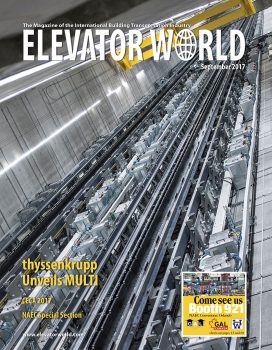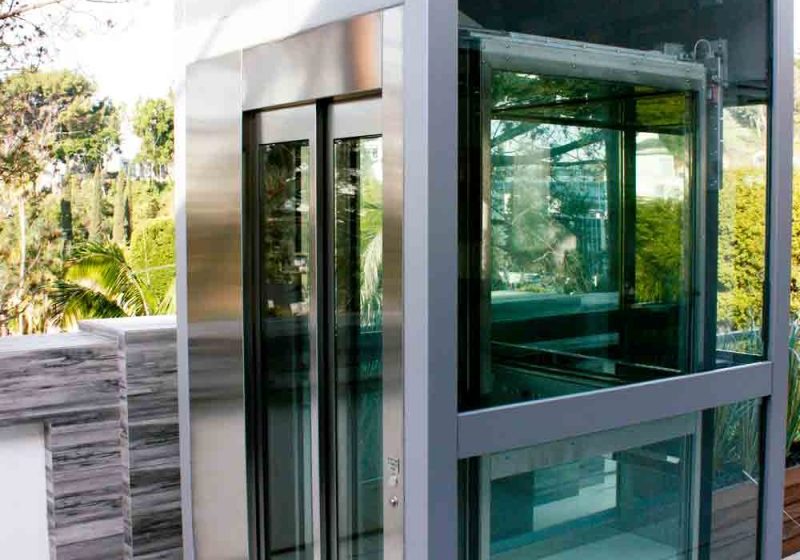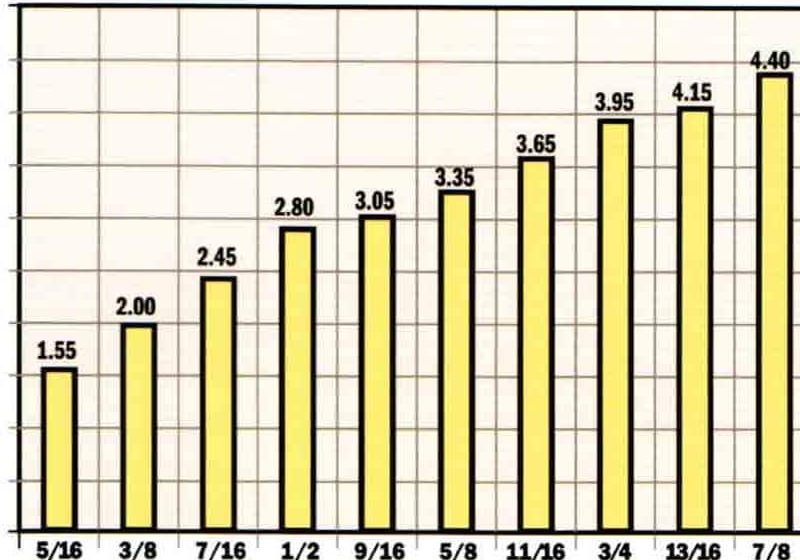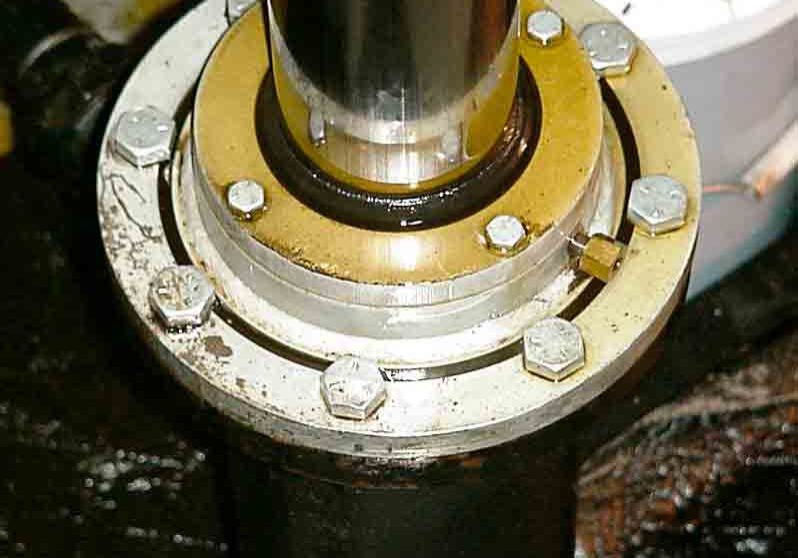Deadline Approaches for 40,000 NYC Elevators
Sep 1, 2017

Devices like GAL FM1 can put units into compliance with new code
by Peter Novak and Steven Ort
The statistics pertaining to elevators can be eye-opening. For instance, according to ConsumerWatch.com, U.S. elevators make 18 billion trips a year.[1] As for safety, the U.S. Bureau of Labor Statistics and the Consumer Product Safety Commission report that, on average, 27 people die, and 10,200 are injured every year nationwide in elevator accidents.[1] And, according to the U.S. Labor Department Census of Fatal Occupational Injuries, a little over half of the deaths occur during the repair, service or maintenance of elevator equipment, or affect people who use elevators as part of their daily employment (such as office workers).[1]
For those with a penchant for percentages, an article by the Los Angeles Times estimated the elevator fatality rate to be 0.00000015% per trip.[3] This is a miniscule percentage, especially when you consider that automobile crashes claim 27 victims every 6-7 hours in the U.S.[4]
It’s not hard to imagine how one could be lulled into a sense of complacency, into thinking that the modern elevator is hardly in need of any modification or improvement. After all, there is a measure of risk, which some might call “acceptable risk,” that a person takes just getting out of bed or crossing the street.
Fortunately, for professionals in the elevator industry, even a small percentage of failure, for any reason, is unacceptable. They understand that even the smallest error can create tragic results. They understand that with today’s 24/7 news cycle and social-media-driven reality, we live in a world where legions of personal-injury lawyers are constantly on the lookout for any elevator accident.
Regulatory bodies and foresighted industry professionals have sought to add various features to the elevator to provide greater passenger safety. Unfortunately, as is often the case with complicated devices, system improvement is also driven by tragic accidents. It was one such tragedy that led to a recent change in the New York City (NYC) Department of Buildings (DOB) Building Code, which must be addressed by January 1, 2020, for elevators to be in compliance. This code change has enormous implications; in fact, the provision impacts up to 40,000 elevators out of the 65,000 throughout the city. It addresses a safety issue that most of the public believes is implicit: that an elevator car will never move with its doors open. Unfortunately, that doesn’t always prove true.
A Tragedy Spurs a Change
Many NYC industry professionals may still recall an incident from December 2011 where a young office worker was killed when the elevator doors at her workplace malfunctioned. Unfortunately, this was not the first instance where either a faulty car door mechanism, poor wiring technique or maintenance worker using a wire jumper — a practice service mechanics often use to bypass elevator safety mechanisms — resulted in a serious accident. The severity of this accident and its occurrence in such a prominent venue, however, were enough to grab headlines and make immediate action imperative. So, even as experts reviewed the circumstances behind the accident, the NYC DOB Elevator Code Committee moved quickly, lobbying the city council to adopt an addition to the building code.
The addition, Appendix K3, Rule 3.10.12, says that means shall be provided to monitor the hall doors and car gate for faulty circuits, and, if a faulty circuit is detected, the elevator shall be prevented from operating and removed from service. This rule applies to all passenger and freight elevators under the jurisdiction of the NYC DOB and sets the deadline for compliance at January 1, 2020.
This code change has enormous implications; in fact, the provision impacts up to 40,000 elevators out of the 65,000 throughout the city. It addresses a safety issue that most of the public believes is implicit: that an elevator car will never move with its doors open. Unfortunately, that doesn’t always prove true.
While the new rule is based on ASME 17.1, Section 2.26.5, “System to Monitor and Prevent Automatic Operation of the Elevator With Faulty Door Contact Circuits,” its firm deadline for compliance gave the measure real teeth. Also, the fact that this provision would apply retroactively to all NYC elevators made this case unique throughout the industry. Certainly, many of NYC’s newer elevator systems already feature controllers with the capability to monitor elevator door faults and prevent potential accidents, and have been installed for years. But, this code change could impact up to 40,000 elevators and affect tens of millions of passenger trips a day.[5] So, the question for many was not whether the rule change was a good idea, but if it could be fully implemented in the time allowed and how much it would cost.
The Solutions at Hand
Today, many companies offer door and gate fault-monitoring mechanisms as add-on features, but whether that option comes installed on a controller often depends on geography. As is often the case, if an AHJ does not specify such a feature in its elevator code, it is often left out. Making the situation more difficult, even if a professional were looking to employ a door and gate fault-monitoring system, it can sometimes be difficult to determine whether a particular controller provides the feature. Though some manufacturers do call attention to it in their sales literature, others mention it only in passing, if at all.
Door-lock monitoring, which is sometimes referred to as “redundancy,” has been included in 17.1 code since 2000 and is in controls built to meet 2000 or subsequent codes. This means that most microprocessor-based controllers built since 2000 (and a few relay-based systems built earlier) either come with monitor circuitry already installed or can be connected to devices that have door fault-monitoring capability. The problem NYC professionals face comes from the vast number of elevators in the city using legacy equipment, which will not easily permit fault monitoring to be added. Elevators are typically required to meet only the code requirements in effect in the year they were installed. The fact that this code change would be enforced retroactively was almost without precedent in the industry.
Current elevators that are performing well may be in compliance with the installation of a new board to an existing controller. The only way to be sure of code compliance is to evaluate your system by using new test procedures mandated by the NYC DOB.
Nearly 40 years ago, GAL Manufacturing Corp. developed technology that provides the ability to detect a jumped or faulty door circuit. Called FM1, the monitoring circuit has been tested and proven, and has sold more than 10,000 units worldwide since its 1978 introduction. Over time, it has become a mainstay in GAL relay, programmable logic and microprocessor controls, and is compatible with most other makes of relay and solid-state controllers.
Available today in microprocessor form, FM1 was designed, patented and manufactured by Walter Glaser of GAL. And, while originally created for an entirely different purpose, FM1’s true potential would be recognized many years later.
FM1: How It Was Developed and Why
In the mid 1970s, the NYC elevator industry saw a huge rise in elevator vandalism. This problem was especially prevalent in the city’s housing projects, schools and college dorms. In addition to burdening building owners with the high cost of fixing demolished buttons and tampered doors, mischief-makers would take dangerous thrill rides on the top of cars (called “elevator surfing”) or run the elevator with open doors. More than an expensive nuisance, such vandalism led to severe accidents.
Pondering a solution, Glaser created rough schematic sketches and used them as the starting point for a series of product prototypes. After refining each variation over time through tests on GAL and non-GAL equipment, the company unveiled a simple solution to the problem under the descriptive but unwieldy name, “Elevator Door Tampering Protection System.” Its primary purpose was to make it impossible for vandals to tamper with the door interlock and gate switch. Any attempt to do so would prevent the elevator from running, keep the doors open and activate an alarm, indicating unauthorized personnel had interfered with the equipment. The design behind this door fault-monitoring circuitry was awarded a patent in 1978 and offered as an additional feature for all nonproprietary GAL controllers. It would soon earn a name that is much easier to remember — the FM1.
Initial sales were sluggish, but after the company re-evaluated the device and saw its potential as a safeguard against car-door accidents caused by human error, GAL began to publicize the device’s merits in industry gatherings, educational forums and onsite visits. FM1 is now used globally and, since 2000, has been incorporated as a feature in all GAL microprocessor-based controllers. Other companies have since developed their own versions of the FM1.
How FM1 Works
In simple terms, an elevator “knows” when to close its doors and depart from a landing, because the controller sends it a signal to do so. The signal is created when monitoring sensors within the car door gate switch make contact with sensors in the interlock on the landing door, completing an electrical circuit that lets the controller know it’s safe to move the elevator. While the system is highly reliable and has proven to be an effective way to do the job, it also offers a way for a maintenance mechanic to create an artificial bridge, or jumper. This would permit the door to stay open so service could be performed by making it appear to the controller that the door was actually closed.
When it’s added to the system, FM1 demands that the electrical signals move forward in a predetermined order. If the specific sequence isn’t followed, the door will appear as open to the controller, which will then keep the car from moving and sound an alarm. This means the product meets the new NYC code provision by constantly monitoring the car and preventing operation with the doors open, regardless of whether an incorrect signal is relayed from the car-door or landing-door contact.
Impact From the Oncoming Deadline
Some elevator professionals are only now starting to consider how the 2020 code change will affect them, and the overall pace to address the situation could best be described as sluggish. Considering that up to 40,000 elevators could be impacted, this has become a cause for concern for many, including GAL Vice President for Business & Development Doug Witham, who said:
“This is a requirement that NYC has to live with. There is a lot of work to be done to comply. I worry that it’s not being taken seriously enough. A lot of time has passed since this requirement was adopted, and it doesn’t seem like much of the work has been completed. I don’t think we should count on an extension.”
On the bright side, the code only stipulates what the change is and when it must be implemented. It doesn’t require that existing equipment be changed; instead, equipment could be simply upgraded to comply. Modernizing an installation can be done at a fraction of the cost of a new system. And, while there may be some who will see any expense to address code compliance as a burden, the liability associated with noncompliance is huge. In addition to loss of service, it can include fines, canceled insurance coverage, legal liabilities and massive inconvenience to tenants.
Current elevators that are performing well may be in compliance with the installation of a new board to an existing controller. Some may think a software upgrade to a controller that provides door fault-monitoring capability will be sufficient, but compliance doesn’t automatically follow. The only way to be sure of code compliance is to evaluate your system by using new test procedures mandated by the NYC DOB.
In addition to the 2020 code situation, professionals also must consider the impact of NYC DOB Building Code Appendix K3 and Rule 3.8.4.1, which must be fulfilled by January 1, 2027. This requirement provides protection against unintentional car movement (UCM) as specified in A17.1 Section 2.19.2. It also requires one to either convert to a dual-plunger brake assembly or incorporate an emergency braking system to prevent UCM and ascending car overspeed (ACO) motion. GAL’s FMG1 can monitor for UCM and ACO, and activate the Hollister-Whitney Rope Gripper® if either condition is indicated.
Regardless of whether you are targeting the upcoming 2020 compliance deadline, or are being proactive and also thinking ahead to 2027, you should move quickly and consult with either GAL or others on how best to address the situation. The technical solutions are out there, and the costs for them are not prohibitive; indeed, the biggest challenge is time. For the NYC elevator industry, the countdown to compliance is well underway, and it can take up to six weeks just to obtain the necessary city permits to proceed. Waiting much longer could risk failure to meet the compliance deadline.
If It’s an NYC Problem, Why Should I Care?
According to statistics, 12% of all U.S. elevators are found in NYC.[5] The impact of a retroactive code change applying to 40,000 elevators throughout NYC should make every professional in the industry take pause. In countries possessing rows of newly built skyscrapers and with plans to build even more, the idea of being proactive, while the fix is relatively easy to accomplish, is a logical one. No doubt, they will encounter problems, too, which means that many around the world will be closely following how the Big Apple handles its compliance situation and use those lessons to guide their efforts.
The biggest question we in the industry face is a simple one: do we put off fixing a potential problem because the actual possibility of it being a cause for passenger death is low, or do we have a responsibility to try to remedy the situation because it is the right thing to do? Defining acceptable risk is always difficult, because everyone has his or her own view of acceptable risk. But, even a remote possibility of a fatality in an elevator is too great, especially for anyone who’s unfortunate enough to be the victim.
References
[1] Consumerwatch.com. (consumerwatch.com/workplace-publicsafety/elevators), Mar. 21, 2017.
[3] Kaplan, Karen. “Are elevators really hazardous to your health?” (LA Times, Dec. 15, 2011).
[4] www.livescience.com/17504-fatal-nyc-accident-elevators-safer-stairs.html. Mar. 20, 2017.
[5] Vyas, Harry. “Summary Elevator Changes 2014 NYC BC,” presentation Nov. 18, 2015.
Get more of Elevator World. Sign up for our free e-newsletter.








